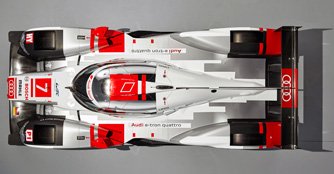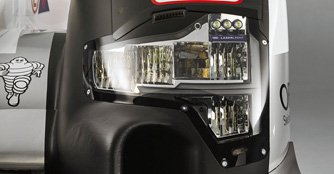Audi to start WEC and Le Mans seasons with revised R18 e-tron quattro
24 Mar 2015|2,200 views
Audi is starting the 2015 season with a thoroughly revised R18 e-tron quattro. In the FIA World Endurance Championship (WEC) and in the Le Mans 24 Hours as the season’s pinnacle event, Audi is going to compete with a hybrid sports car in the four-megajoule class.

New lighting units feature Matrix LED technology combined with Audi Laserlight - two innovations that improve active safety in road traffic and that Audi customers can now order for their production models as well.
While Audi has adopted the monocoque - the central safety cell of the race car - from the previous model, the hood with the front wing and wheel arches features a new design. Modified airflow through the sidepods with new radiator configurations for cooling the engine and the hybrid system further optimises aerodynamic drag. The engine cover, which encloses the unit even more tightly and notably tapers off behind the cockpit, contributes to this as well.

During braking, energy is recovered which the system subsequently feeds back to the front axle on acceleration. The electrical machine that performs this task now delivers an output of more than 200kW (272bhp), which is a significant increase compared to last year.
Therefore, Audi has increased the capacity of the energy storage system as well. The encapsulated flywheel energy storage system that sits in the cockpit alongside the driver can store up to 700 kilojoules of energy that it subsequently returns to the electrical machine - which is about 17 percent more than in 2014.
The improved hybrid output, however, results in a restriction for the internal combustion engine. According to the sporting regulations, the fuel energy amount has to be further reduced if the engineers opt for higher hybrid output. As a result, the R18 e-tron quattro has to make do with 2.5 percent less diesel fuel per lap than in 2014.
Not least for this reason, Audi has further developed the 4.0-litre V6 TDI engine by performing a lot of detailed work to achieve the optimised consumption levels. The most efficient powerplant in the field now delivers 410kW (558bhp). Due to its optimised consumption the developers have managed to more than compensate for the loss in output resulting from the reduced amount of fuel. As another new rule this year, only five engines per race car may be used during the entire season. The powerplant now delivering even greater fuel efficiency continues a major trend.
Audi is starting the 2015 season with a thoroughly revised R18 e-tron quattro. In the FIA World Endurance Championship (WEC) and in the Le Mans 24 Hours as the season’s pinnacle event, Audi is going to compete with a hybrid sports car in the four-megajoule class.
The fifth generation of the R18 e-tron quattro visually differs clearly from its predecessor even though its basic structure is closely akin to the previous model. The fresh look results from a new way of conducting airflow around and through the front end, in the area of the sidepods and at the rear of the LMP1 prototype.
New lighting units feature Matrix LED technology combined with Audi Laserlight - two innovations that improve active safety in road traffic and that Audi customers can now order for their production models as well.
While Audi has adopted the monocoque - the central safety cell of the race car - from the previous model, the hood with the front wing and wheel arches features a new design. Modified airflow through the sidepods with new radiator configurations for cooling the engine and the hybrid system further optimises aerodynamic drag. The engine cover, which encloses the unit even more tightly and notably tapers off behind the cockpit, contributes to this as well.
Hybrid pioneer Audi is taking the next step in the area of energy recovery as well. For this year, the engineers have doubled the amount of energy from two to four megajoules per race lap at Le Mans.
During braking, energy is recovered which the system subsequently feeds back to the front axle on acceleration. The electrical machine that performs this task now delivers an output of more than 200kW (272bhp), which is a significant increase compared to last year.
Therefore, Audi has increased the capacity of the energy storage system as well. The encapsulated flywheel energy storage system that sits in the cockpit alongside the driver can store up to 700 kilojoules of energy that it subsequently returns to the electrical machine - which is about 17 percent more than in 2014.
The improved hybrid output, however, results in a restriction for the internal combustion engine. According to the sporting regulations, the fuel energy amount has to be further reduced if the engineers opt for higher hybrid output. As a result, the R18 e-tron quattro has to make do with 2.5 percent less diesel fuel per lap than in 2014.
Not least for this reason, Audi has further developed the 4.0-litre V6 TDI engine by performing a lot of detailed work to achieve the optimised consumption levels. The most efficient powerplant in the field now delivers 410kW (558bhp). Due to its optimised consumption the developers have managed to more than compensate for the loss in output resulting from the reduced amount of fuel. As another new rule this year, only five engines per race car may be used during the entire season. The powerplant now delivering even greater fuel efficiency continues a major trend.
Latest COE Prices
May 2025 | 1st BIDDING
NEXT TENDER: 21 May 2025
CAT A$103,009
CAT B$119,890
CAT C$62,590
CAT E$118,889
View Full Results Thank You For Your Subscription.





















